Clinical Neuropsychology and Technology: What’s New and How We Can Use It
Autor Thomas D. Parsonsen Limba Engleză Hardback – 8 apr 2016
This book covers in depth:
· The evolution of neuropsychological testing over the past century.
· Current applications of computer-based neuropsychological assessments. · The strengths and limitations of simulation technology.
· The use of teleneuropsychology in reaching remote clients.
· The potential of gaming technologies in neurocognitive rehabilitation.
· How technology can transform test data into information useful across specialties.Clinical Neuropsychology and Technology brings neuropsychologists, clinical psychologists, and rehabilitation specialists into the vanguard of assessment measures and processes that will translate into more accurate testing, collaborations between disciplines, and valid and useful outcomes.
| Toate formatele și edițiile | Preț | Express |
|---|---|---|
| Paperback (1) | 396.95 lei 38-44 zile | |
| Springer International Publishing – 25 apr 2018 | 396.95 lei 38-44 zile | |
| Hardback (1) | 452.67 lei 38-44 zile | |
| Springer International Publishing – 8 apr 2016 | 452.67 lei 38-44 zile |
Preț: 452.67 lei
Preț vechi: 558.84 lei
-19% Nou
Puncte Express: 679
Preț estimativ în valută:
86.62€ • 90.44$ • 71.69£
86.62€ • 90.44$ • 71.69£
Carte tipărită la comandă
Livrare economică 01-07 aprilie
Preluare comenzi: 021 569.72.76
Specificații
ISBN-13: 9783319310732
ISBN-10: 3319310739
Pagini: 190
Ilustrații: XIX, 190 p.
Dimensiuni: 155 x 235 x 17 mm
Greutate: 0.48 kg
Ediția:1st ed. 2016
Editura: Springer International Publishing
Colecția Springer
Locul publicării:Cham, Switzerland
ISBN-10: 3319310739
Pagini: 190
Ilustrații: XIX, 190 p.
Dimensiuni: 155 x 235 x 17 mm
Greutate: 0.48 kg
Ediția:1st ed. 2016
Editura: Springer International Publishing
Colecția Springer
Locul publicării:Cham, Switzerland
Cuprins
Introduction.- Historical development of neuropsychology's changing roles and tools.- Improved ecological validity throughout enhanced technologies.- Frontal subcortical circuits and modeling of hot and cool cognitive functioning.- Assessment.- Overview of computerized neuropsychological assessment devices.- Psychometric issues in neuropsychological assessment using novel technologies.- Construct-driven technologies for assessments of cognitive functioning.- Function-led scenarios: representativeness and generalizability.- Rehabilitation.- Gamification of neurocognitive approaches to rehabilitation.- Neurocognitive and psychophysiological interfaces for adaptive rehabilitation.- Neuroimaging to model neurocognitive function and guide rehabilitation.- Telemedicine and e-Health.- Teleneuropsychology and evidence-based practice.- Ecological momentary interventions: incorporating mobile technology.- Metaverse platforms and the potential of assessment using MOMPGs.- Neuroinformatics for Neuropsychologists.- Artificial neural networks: from neuroscience to clinical neuropsychology.- Interpreting technologically enhanced neuropsychological assessment data.- Collaborative neuropsychological knowledge bases.- Conclusions.- Advanced technology and assessment: ethical and methodological considerations.- Future prospects for a computational neuropsychology.
Recenzii
“Thomas Parsons’s book … serves as a call to arms for practicing neuropsychologists, neuropsychologists in training, and clinical training programs. … Parsons’s book drives home the need for neuropsychologists and test developers to embrace advances in technology, to move forward in adopting new test methods, and to implement a new standard and paradigm for developing neuropsychological measures. The intended audience includes neuropsychologists, students of neuropsychology, and individuals with computer programming experience and an interest in brain and behavior.” (Laura Grande, PsycCRITIQUES, Vol. 61 (52), December, 2016)
Notă biografică
Thomas D. Parsons, PhD is a Clinical Neuropsychologist and Associate Professor of Psychology at the University of North Texas. Prior to joining the faculty at UNT, he was an Assistant Professor and Research Scientist at the University of Southern California’s Institute for Creative Technologies. His work integrates neuropsychology and simulation technologies for novel assessment, modeling, and training of neurocognitive and affective processes. He is a leading scientist in this area and he has directed 17 funded projects during his career and he has been an investigator on an additional 13 funded projects. In addition to his patents for the eHarmony.com Matching System, he has invented and validated virtual reality-based assessments of attention, spatial abilities, memory, and executive functions. He uses neural networks and machine learning to model mechanisms underlying reinforcement learning, decision making, working memory, and inhibitory control. He has over 100 publications in peer reviewed journals and book chapters. His contributions to neuropsychology were recognized when he received the 2013 National Academy of Neuropsychology Early Career Achievement award. In 2014, he was awarded Fellow status in the National Academy of Neuropsychology.
Textul de pe ultima copertă
This ambitious and accessible guide reviews innovative technologies enhancing the field of neuropsychological testing. Starting with the premise that standard batteries—some nearly a century old—lag behind in our era of neuroimaging, genomic studies, psychophysiology, and informatics, it presents digital measures offering more efficient administration, more accurate data, and wider clinical applications. Ecological validity and evidence-based science are key themes in these advances, from virtual environments and assessment of social cognition to the shift toward situational reliability and away from lab-created constructs. These chapters also demonstrate how high-tech assessment tools can complement or supplement traditional pencil-and-paper measures without replacing them outright.
This book covers in depth:
· The evolution of neuropsychological testing over the past century.
· Current applications of computer-based neuropsychological assessments. · The strengths and limitations of simulation technology.
· The use of teleneuropsychology in reaching remote clients.
· The potential of gaming technologies in neurocognitive rehabilitation.
· How technology can transform test data into information useful across specialties.Clinical Neuropsychology and Technology brings neuropsychologists, clinical psychologists, and rehabilitation specialists into the vanguard of assessment measures and processes that will translate into more accurate testing, collaborations between disciplines, and valid and useful outcomes.
This book covers in depth:
· The evolution of neuropsychological testing over the past century.
· Current applications of computer-based neuropsychological assessments. · The strengths and limitations of simulation technology.
· The use of teleneuropsychology in reaching remote clients.
· The potential of gaming technologies in neurocognitive rehabilitation.
· How technology can transform test data into information useful across specialties.Clinical Neuropsychology and Technology brings neuropsychologists, clinical psychologists, and rehabilitation specialists into the vanguard of assessment measures and processes that will translate into more accurate testing, collaborations between disciplines, and valid and useful outcomes.
Caracteristici
Presents solutions to lack of ecological validity in neuropsychological assessment Presents solutions to the lack of technological progress in neuropsychological assessments Addresses the changing role of neuropsychologists in a technologically advancing field Includes supplementary material: sn.pub/extras














